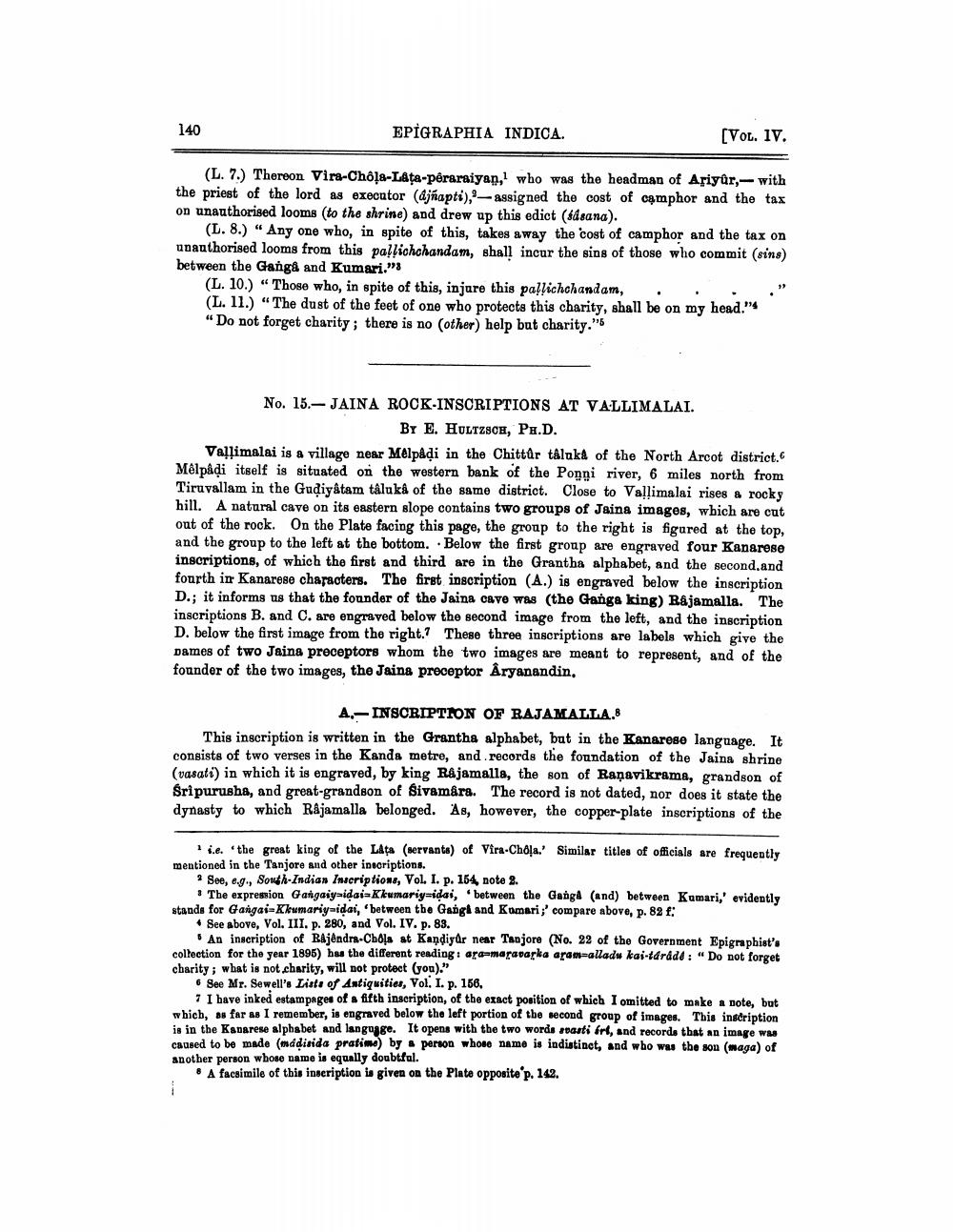________________
140
EPIGRAPHIA INDICA.
[Vol. IV.
(L. 7.) Thereon Vira-Chôļa-Låta-pêraraiyan, who was the headman of Ariyûr, with the priest of the lord as executor (djñapti), - assigned the cost of camphor and the tax on unauthorised looms (to the shrine) and drew up this edict (sdsana).
(L. 8.) "Any one who, in spite of this, takes away the cost of camphor and the tax on unauthorised looms from this palsichchandam, shall incur the sins of those who commit (sins) between the Ganga and Kumari."
(L. 10.) “Those who, in spite of this, injare this paffichchandam, . . (L. 11.) “The dust of the feet of one who protects this charity, shall be on my head." "Do not forget charity; there is no (other) help but charity."
No. 15. - JAINA ROCK-INSCRIPTIONS AT VALLIMALAI.
By E. HULTZSCH, PH.D. Vallimalai is a village near Melpadi in the Chittar tåluka of the North Arcot district. Mêlpadi itself is situated on the western bank of the Ponni river, 6 miles north from Tiruvallam in the Gudiy&tam tâluka of the same district. Close to Vallimalai rises & rocky hill. A natural cave on its eastern slope contains two groups of Jaina images, which are cut out of the rock. On the Plate facing this page, the group to the right is figured at the top, and the group to the left at the bottom. Below the first group are engraved four Kanarese inscriptions, of which the first and third are in the Grantha alphabet, and the second and fourth in Kanarese characters. The first inscription (A.) is engraved below the inscription D.; it informs us that the founder of the Jaina cave was (the Ganga king) Bajamalla. The inscriptions B. and C. are engraved below the second image from the left, and the inscription D. below the first image from the right. These three inscriptions are labels which give the Dames of two Jaina preceptors whom the two images are meant to represent, and of the founder of the two images, the Jains preceptor Åryanandin,
A.- INSCRIPTION OF RAJAMALLA.8 This inscription is written in the Grantha alphabet, but in the Kanarese language. It consists of two verses in the Kanda metre, and records the foundation of the Jains shrine (vasati) in which it is engraved, by king Råjamalla, the son of Raņavikrama, grandson of Sripurusha, and great-grandson of Sivamars. The record is not dated, nor does it state the dynasty to which Rajamalla belonged. As, however, the copper-plate inscriptions of the
s.e. the great king of the Laţa (servants) of Vira-Chôļa.' Similar titles of officials are frequently mentioned in the Tanjore and other inscriptions.
See, ag., South Indian Inscriptions, VOL. I. p. 154, note 2.
• The expression Gangaiyidai=Kkumariyaidai, between the Ganga (and) between Kumari,' evidently stands for Gangai-Klumariysidai, between the Gangland Komari' compare above, p. 82 f:
• See above, Vol. III. p. 280, and Vol. IV. p. 88.
An inscription of Rajendra-Chols at Kandiyar near Tanjore (No. 22 of the Government Epigraphist's collection for the year 1896) bus the different reading: aramararaska ardealladw kai ldridt: "Do not forget charity; what is not charity, will not protect (you)."
6 See Mr. Sewell's List of Antiquities, Vol. I. p. 156,
7 I have inked estampages of a fifth inscription, of the exact position of which I omitted to make a note, but whicb, as far as I remember, is engraved below the left portion of the second group of images. This inscription is in the Kanarese alphabet and langugge. It opens with the two words rasti frl, and records that an image was caused to be made (mddinida pratimo) by person whose name is indistinct, and who was the son (naga) of another person whose name is equally doubtful.
• A facsimile of this inscription is given on the Plate opposito'p. 142.




